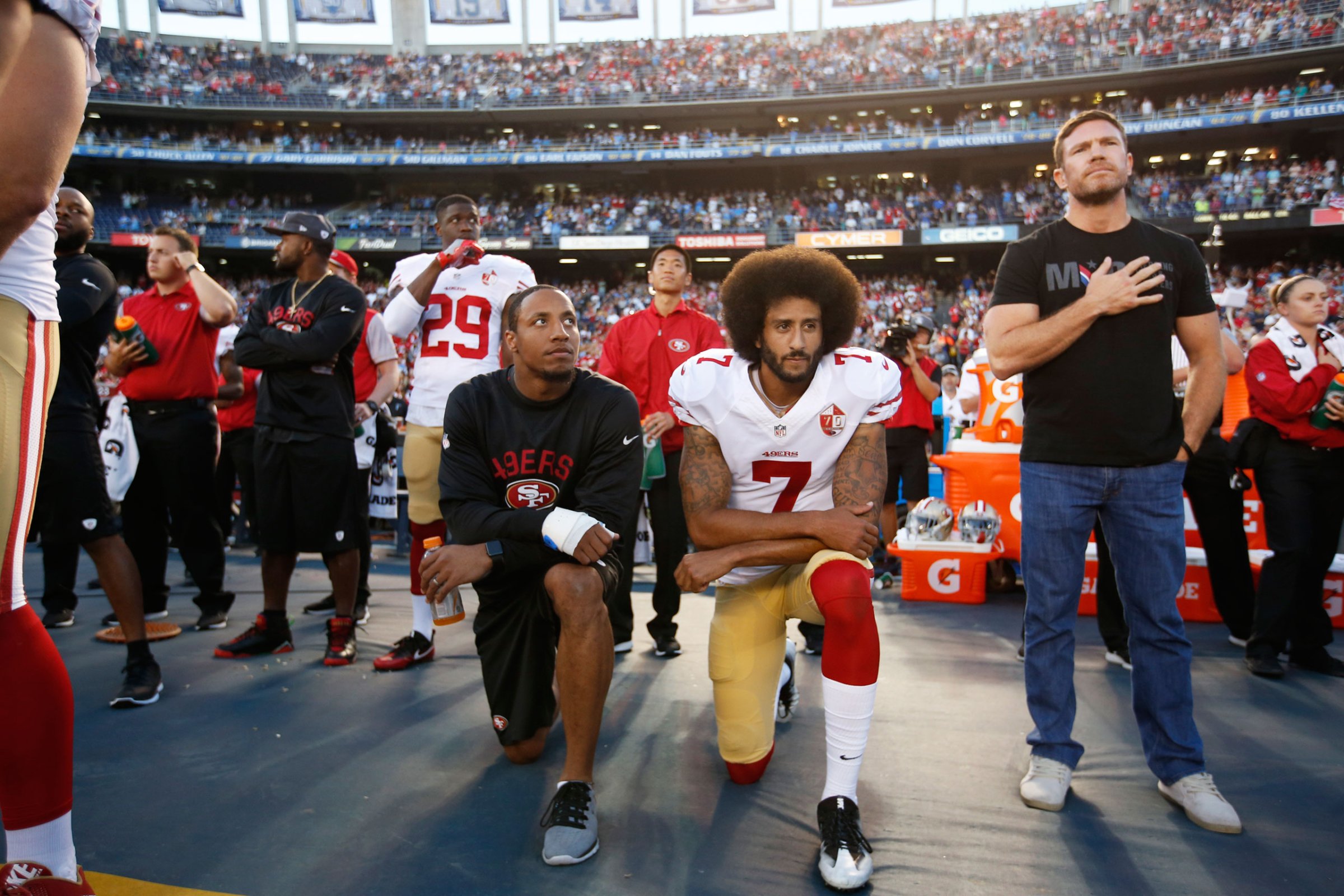
With hundreds of thousands of fans packed into stadiums across the country and millions more watching on TV, the NFL kicked off its new season on Sept. 11 with a ritual that has become a given at American sporting events: playing the national anthem. Only this time, not every athlete went along. Following the lead of San Francisco 49ers quarterback Colin Kaepernick, who said he stopped standing during the song in the preseason as a way not to “show pride in a flag for a country that oppresses black people and people of color,” players on teams throughout the league chose to kneel, raise their fists or lock arms in solidarity.
Criticism rained down hard. The protesting players have been called stupid, entitled and disrespectful by fans and hot-take columnists (never mind that Kaepernick and others have been vocal about their support for the military and protest as a form of patriotism). But in addition to the conversation about racial injustice, the controversy raises another question: Should the national anthem be played at sporting events in the first place?
This is a decidedly American issue. Outside of international competitions like the Olympics, anthems are rarely heard at sporting events in other countries (though “O Canada” is in heavy rotation at games). Nor do America’s other communal entertainment events, like the Academy Awards or Broadway plays, begin with a rousing rendition of “The Star-Spangled Banner.” What makes ball games especially patriotic?
Not surprisingly in the nation that regularly builds billion-dollar stadiums, the answer is a mix of good intentions and shrewd opportunism. The first documented playing of “The Star-Spangled Banner” at a sporting event dates back to 1862, when a band played the song before a baseball game in Brooklyn. But its most prominent first steps toward becoming a tradition date to Game 1 of the 1918 World Series, between the Chicago Cubs and Babe Ruth’s Boston Red Sox. Swelling with World War I patriotism, a band played the anthem during the seventh-inning stretch. Fans sang along with gusto, players stood at attention, and Red Sox third baseman Fred Thomas, on furlough from the Navy, gave a military salute. Noting the reaction, Red Sox owner Harry Frazee, a theater impresario, moved the pageantry to the pregame when the series shifted to Boston and added another filigree by honoring wounded soldiers.
Still, the anthem was typically reserved for special moments like opening day, holidays and the World Series–until World War II, when it was amplified, thanks to a renewed wave of national pride and the new technology of loudspeakers. “A ritual like the national anthem became part of the war effort on the home front, and says that sports is committed to all things American,” says Mark Clague, an expert on “The Star-Spangled Banner” at the University of Michigan. “It defines sports as patriotic.” In other words: it’s good propaganda.
But if the larger goal of linking sports and patriotism is to create more meaningful support of one’s country, there’s more that leagues–and fans–could be doing than belting an anthem. According to a 2015 report from Arizona Senators Jeff Flake and John McCain, many of the pregame displays of flag waving, troop saluting and national-anthem performing have been paid for with public money (as a result of contracts between the Department of Defense and teams from the NFL, MLB, NBA, NHL and MLS). What if they were used to raise money too? The average price of an NFL ticket in 2015, for example, was $86. Even allocating a small amount (say, 50¢) of each sale to a worthy organization could generate millions of dollars, if applied to each one of the 32 teams. And that money could be spent on everything from aiding veterans to civics education.
None of this is to suggest that there’s any harm in playing the national anthem before sports games on its face. But if fans are going to react so strongly to someone kneeling during it, as if that somehow signals a blow to America itself, it’s time to re-evaluate how patriotic the gesture really is.
For more on these stories, visit time.com/ideas
More Must-Reads from TIME
- Why Trump’s Message Worked on Latino Men
- What Trump’s Win Could Mean for Housing
- The 100 Must-Read Books of 2024
- Sleep Doctors Share the 1 Tip That’s Changed Their Lives
- Column: Let’s Bring Back Romance
- What It’s Like to Have Long COVID As a Kid
- FX’s Say Nothing Is the Must-Watch Political Thriller of 2024
- Merle Bombardieri Is Helping People Make the Baby Decision
Write to Sean Gregory at sean.gregory@time.com